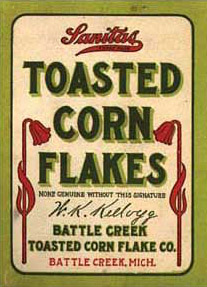
When did people start eating cereal for breakfast? Technically in the 1850s, but it didn’t catch on until the early 1900s.
The first breakfast cereal (albeit hot) was invented by Ferdinand Schumacher, a German immigrant living in America. He used a hand grinder to grind oats that he then sold for oatmeal. The oats were generally cooked in hot water or milk to soften them. He later rebranded his business as Quaker. The Quaker Oats company obviously still exists.
The first cold breakfast cereal was made by James Caleb Jackson in 1863. He was the owner of a health sanitarium and he was looking for a healthy breakfast to replace the breakfasts that were common at the time. He was a vegetarian and a nutritionist. He believed that fruit, vegetables, and unprocessed grains were the key to health. He used bran-rich graham flour to make a breakfast cereal he called granula. He rolled the graham flour dough into sheets and baked it. Then he broke the cooked sheet into pieces and baked it again. He broke the twice baked pieces into even smaller pieces and that was his cereal. The granula was undoubtedly healthy, but it was incredibly hard. It had to be soaked overnight in water or milk before it could be eaten.
As an aside: Graham flour was named for Sylvester Graham. He was an American Presbyterian minister who believed that vegetarianism, temperance, and eating whole-grain bread could make people healthy and allow them to conquer their body’s physical urges. He believed that flour for bread should be milled at home and the germ and bran should not be thrown away. A movement called Grahamism sprang up and a number of health foods were named after him.
So, why was there a sudden interest in breakfast cereal in the 1850s and 60s? Why didn’t the invention of breakfast cereal come earlier? There are two reasons.
The first reason was the huge change in the way that people lived their lives. People generally didn’t eat breakfast in the Middle Ages. It wasn’t considered important and most people would head out to work on their farms without eating anything. Most people would only eat at midday and in the evening. People working on farms would usually stop at lunchtime and go home to eat a largish meal. By the 16th century, wealthy people and the middle classes had started to have some form of breakfast that usually consisted of breads and meats. Poor people still didn’t eat breakfast.
The Industrial Revolution changed all of that. People moved from rural areas into the cities and started working in factories. It became impossible to go home at lunchtime to have a large meal, so people ended up eating much smaller lunches. The workers were doing hard manual work and they needed the energy. If they couldn’t get it at lunch, the only alternative was to start having a breakfast.
The second reason was that people were becoming unhealthy. Most people ate meat, bread, cheese, porridge, leftovers from the night before, in fact, pretty much anything for breakfast. Breakfasts were becoming larger and there was a general worry about public health. Diseases were rampant and many people thought that the changing diet caused by the Industrial Revolution was to blame. For some diseases it definitely was, but not all. A number of different sanitariums and “nutritionists” sprang up across America to help people.
And it is from these sanitoriums that the idea of cereal for breakfast came. James Caleb Jackson was a firm believer that diet was vital for health. He was a vegetarian and he abstained from alcohol, tobacco, tea, coffee, and any stimulants. His granula breakfast cereal was healthy, but not popular.
In 1877, another religious nutritionist helped to make a cereal that would become popular. Dr. John Harvey Kellogg ran a Seventh-day Adventist Sanatorium in America. He also believed that vegetarianism, temperance, and healthy food were the way to fix people. He made a dough from flour, oats, and cornmeal, which he backed twice. He then smashed the baked dough into small pieces.
Dr. Kellogg called this breakfast cereal Granose, which was a combination of the words grain and the suffix –ose. The cereal was very popular in the sanitorium. Dr. Kellogg was only interested in the sanitorium. His brother, Will Kellogg, was interested in marketing the cereal to regular people. He saw a great opportunity. The two brothers didn’t get on and Dr. Kellogg appears to have been something of a bully. Will Kellogg bought the rights to the cereal, and set up the Battle Creek Toasted Corn Flake Company in 1906. He added malt, sugar, and salt to the mix (something his brother would never have done) and marketed the cereal as an easy and substantial breakfast. He used most of the profits for advertising and Kellogg’s cornflakes became a massive hit.

It wasn’t long before people saw the opportunity and other cereals began to enter the market.
So, when did people start eating cereal for breakfast? In the 1950s, but it wasn’t mainstream until the early 20th century. And this is what I learned today.
Sources:
https://www.wpr.org/historian-industrial-revolution-gave-us-lunch-we-know-it
https://en.wikipedia.org/wiki/Breakfast
https://en.wikipedia.org/wiki/Breakfast_cereal
https://en.wikipedia.org/wiki/Granula
https://en.wikipedia.org/wiki/James_Caleb_Jackson
https://www.refinery29.com/en-us/2021/03/10380335/breakfast-cereal-history-future-strange-facts
https://www.history.com/news/cereal-breakfast-origins-kellogg
https://en.wikipedia.org/wiki/Sylvester_Graham
